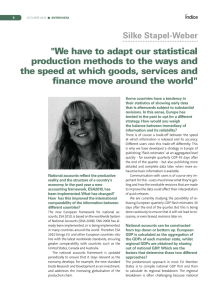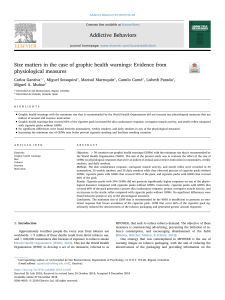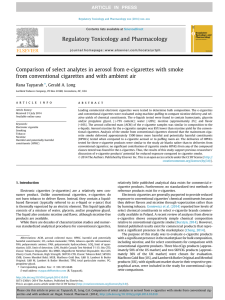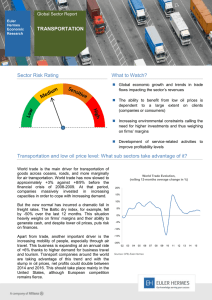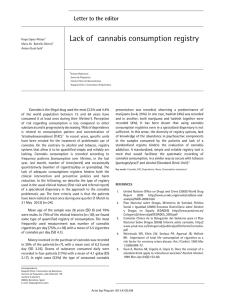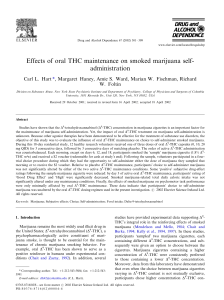Documento de Trabajo - Aleph Ciencias Sociales
Anuncio
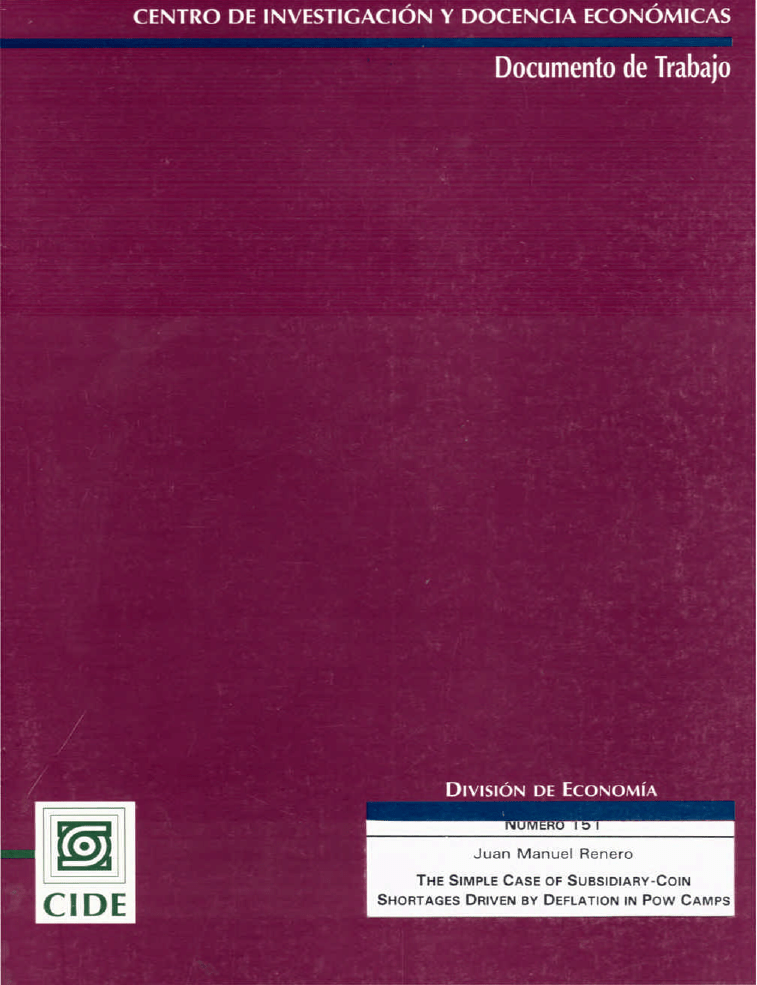
CENTRO DE INVESTIGACIÓN Y DOCENCIA ECONÓMICAS
5rtiü»ariffiHaffrmr í^^ -
Documento de Trabajo
[_->s3sg!^ 'íiae^KSí"^
DIVISIóN DE ECONOMíA
IMUMtHO I D I
Juan Manuel Renero
THE SIMPLE CASE OF SUBSIDIARY-COIN
SHORTAGES DRIVEN BY DEFLATION IN POW CAMPSI
Las colecciones de Documentos de Trabajo del CIDE representan un medio para difundir los avances de la labor de investigación, y para permitir que los autores reciban comentarios
antes de su publicación definitiva. Se agradecerá que los comentarios se hagan llegar directamente al (los) autor(es).
♦ D.R. S 1999, Centro de Investigación y Docencia Económicas, A. C., carretera México-Toiuca 3655 (km. 16.5),
Lomas de Santa Fe, 01210 México, D. F., tel. 727-9800,
fax: 292-1304 y 570-4277. ♦ Producción a cargo del (los)
autor(es), por lo que tanto el contenido como el estilo y la
redacción son responsabilidad exclusiva suya.
CIDE
NÚMERO 151
Juan Manuel Renero
THE SIMPLE CASE OF SUBSIDIARY-COIN
SHORTAGES DRIVEN BY DEFLATION IN POW CAMPS
ABSTRACT
I modify a prototypical random-matching model of money to get a simple model which match
observations of POW camps' simple economies -say, the use of cigarettes as currency through
macroeconomic fluctuations. One new result is that deflation may bring about a shortage of
subsidiary coin in the sense that some exchanges do not occur because an indivisible "cigarette"
becomes "too valuable". This result is particularly interesting because it has been argued that
currency shortages would be relieved by the resulting increase in the valué of money; that is,
deflation. However, this argument does not take into account currency indivisibility.
RESUMEN
Un modelo prototipo de dinero basado en apáreos aleatorios es modificado con el fin de obtener
un simple modelo que reproduzca observaciones de simples economías en campos de prisioneros
de guerra -digamos, el uso de cigarrillos como moneda a través de fluctuaciones
macroeconómicas. Un nuevo resultado es que deflación puede producir una escasez de moneda
subsidiaria en el sentido de que algunos intercambios no ocurren porque un "cigarrillo"
indivisible llega ser "muy valioso." Este resultado es particularmente interesante porque ha sido
argüido que cualquier escasez de moneda sería mitigada por el resultante incremento en el valor
del dinero; o sea, deflación. Sin embargo, este argumento no toma en cuenta la indivisibilidad de
la moneda.
íntroduction
Imodify a prototypical random-matching model of money to match obsen'ations of
POW camps' simple economies —say, the use of cigarettes as currency. One result
is that deflation may bring about a shortage of subsidiary coin in the sense that
some exchanges do not occur because an indivisible "cigarette" becomes too valuable
to be exchanged for some goods and there is not available low-denomination
currency. This resuh is particularly interesting because it can be argued that currency
shortages may be reheved by the resuhing increase in the 'Valué" of money or
deflation. However, this argument does not take into account currency indivisibihty
as pointed out by Wallace-Zhou [1997].
The examples exhibited in this paper are so simple that simple arithmetic is
enough to work them out. These examples are simple economies of Wallace [1997]
but with finite horizon, no exogenous upper-bound on asset holdings, and small costs
of handhng "money". In those simple economies, the role of media of exchange in
equihbrium is played by objects (say, cigarettes) that are usefiíl only to a fraction of
agents (say, a fraction of agents is smoker). As far as I know, no researcher has even
conjectured this modification which can be arbitrarily small. In this way we do not
found any problems because a certain, or sure, last date as it is argued in Wallace
[1997] and elsewhere. Moreover, m contrast to Kultti [1995], my examples are
robust to the Íntroduction of "handling" costs of giving (or even receiving) cigarettes
because they are assumed exphcitly to reduce the set of equilibria. Therefore, we do
not have to work with practically infinite-horizon economies and, consequently, to
deal with mathematical difBculties. In tura, finite-horizon economies allow us not to
assume an exogenous upper-bound for monetary holdings as it has been common
practice although it has been also regarded as unappealing.
Perhaps reading the Radford [1945]'s description of the simple economy of a
POW camp, one may feel less strong the assumption of random matching of agents in
an economy. In particular, the foUowing description of a "transit camp" may give
some interest to the model presented in this paper:
Atransit camp was always chaotic and uncomfortable: people were overcrowded, no
one knew where anyone else was living, and few took the trouble to fínd out
Orgarusation was too slender to include an Exchange and Mart board, and pnvate
advertísements were the most that appeared Consequently, a transit camp was not
one market but many. (p. 191 -192)
In this context I would like to argüe that the assumption of finite horizon may have
some justification since prisoners in a transit camp perhaps knew that they would be
Renero Juan M The Simple case ofsubsidiary-coin.
translated to another camp by some date. In any case, may be helpful to discuss the
assumptions and results in the context of POW camps.
I regard my examples altogether as a "simple experiment". We wiU see two
economies with difFerent exogenously-given quantity of indivisible currency, say
cigarettes. Otherwise, they are identical. Observing the equilibria, we will see that in
the currency-starved economy, some possible transactions do not occur as in the
other economy. The mtuition is that there exists a shortage of low-denomination
currency because of deflation. Moreover, Radford [1945] describes that when
cigarette deliveries were interrupted "prices fell, trading declined in volume and
became increasingly a matter of barter." And he immediately adds that this
"deflationary tendency was periodically oflFset by the sudden injection of new
currency." (p. 195) Perhaps my examples may illustrate these fluctuations although
not across time in only one economy but across economies which seems to be a lot
more convenient.
The hterature about modeling money using random matching is enormous and
difiBcult. The remotely-direct reference which I am famüiar with is Kiyotaki-Wright
[1989]. The iirmiediate direct reference is Wallace [1997] as already suggested.
Perhaps, this is the simplest model in the pubhshed Hterature and it seems to me an
enjoyable reading. As far as 1 know, the unique reference on modeling shortages of
indivisible currency using random matching is Wallace-Zhou [1997]. It presents a
concise description of the discussion on currency shortages and exhibit an
equilibrium, say under free trade, which is argued to be the "modeFs representation
of currency-shortage observations". Moreover Wallace-Zhou exhibit other
equilibrium in which some trade is exogenously restricted, say International autarky is
imposed. Both equüibria are not Pareto comparable, but with a representative-agent
criterion autarky is preferred. In this sense, their "model rationalizes a prohibition on
the export of currency" (p. 557). Fmally, I should mention Burdett-Trejos-Wright
[July, 1998] who try to follow the story of POW camps in a different randommatching model with the exogenous upper-bound for cigarette holdings of one unit.
This paper is organized as follows. In the nexl section is described the
physical environment. In the third section the examples are given and explained
independently from each other for reader's convenience. In the fourth section, some
concluding remarks are made. The Figure and the Tables mentioned in text are at the
end of the paper.
The Physical Environment
Because my model is a modification of Wallace [1997]. I describe first the
new and key assumptions. Time is discrete with a finite horizon. TTiere exist
Renero Juan M. The Simple case ofsubsidiary-coin.
individual endowments of cigarettes which are durable and indmsible. I assume that a
cigarette is completely smocked or not at all, prisoners cannot produce cigarettes,
and there exists a positrve fraction of prisoners who get utility from smoking. There
exists small costs of giving cigarettes. For simplicity, I assume that there does not
exist costs in accepting cigarettes.
I describe now the standard assumptions with the appropriate modifications
derived of the new assumptions. At each period, there exist A' > 3 goods which are
perishable (say, services) and divisible. There exist jVtypes of prisoners. Type i gets
utility only from consuming service i and possibly from smoking. Type i produces
only service /+/ (modulo N) at the expense of some disutility. As regards services,
notice that this assumption impües that in a pairwise meetmg, there is not double
coincidence of wants; that is, there cannot be barter with services alone.
The utUity at any period is the sum of the utiüty from consumption and the
disutüity from producing. I assume also that the utihty from smoking adds to the
utiüty at any period. Through the life of the economy, prisoners maximize expected
discounted utility.
There is a [0,1] continuum of agents for each type. I assume also equal
fractions of smokers for each type. Each prisoner is randomly matched with one
other prisoner, where the probabUity of a prisoner meeting another prisoner with
given characteristics is the proportion of those people in the entire population. A
service is produced and possibly consumed at the meetings of each period.
In a meeting prisoners bargain to trade. The bargaining rule assumed is that
he potential consumer of a service makes a "take it or leave it" ofifer. We also assume
that if a potential producer is indifferent between accepting or rejecting an offer,
he/she accepts the offer.
Prisoners can not commit themselves to ftiture actions. Any prisoner can exit
any meeting with the cigarettes with which arrived to the meeting, and cannot be
forced to render any service at any meetmg. Types and inventories are known in each
meeting. Trading histories of agents are private Information
Finally, the assumed timing of actions for an economy of two periods is
indicated in figure 1.
Figure 1
Timing of actions assuming an economy of two period:
Cigarrette
Endowments
Cigarette
Endowments
Renero Juan M.The Simple case ofsubsidiary-coin.
Possibly
Smoking
Possibly
Smoking
►
:RANDOM
íPAIRWISE
íMEETINGS
:RANDOM
íPAIRWISE
íMEETINGS
J
Two Examples
Iníroduction
As is standard, the equilibrium concept is a Nash equilibrium (in fact. a
perfect-subgame equilibrium) with rational expectations.
I describe next the particular assumptions which constitute my examples.
There are two periods, say period 1 and period 2. The utiüty functions of a prisoner
at any period are
((x)"^ if the prisoner comumes X of his preferred service
O
s[a]^
otherwise
\9{ay n
O
// a smoker smokes a cigarettes
if a nonsmoker smokes a cigarettes
l[y] = -y ifhe produces y ofhis specialized service
The discount factor is (3 = 0.9. One half of agents is smoker. There are N = 3 types of
agents and services. The cost of giving n cigarettes is £[n] = 0.1. In both economies,
each prisoner is endowed with one cigarette at period 1, Moreover, in Economy A
each prisoner is endowed with zero "cigarettes" and in Economy B each prisoner is
endowed with one "cigarette" at period 2.
Renero Juan M.The Simple case ofsubsidiary-coin.
Next, I describe the main differences of trade across economies. At the first
period, in a single-coincidence meeting between two nonsmokers: Trade does not
occur in Economy A: The potential consumer 's best strategy is not to sale his
cigarette for his/her preferred service at the "reservation pnce" of the potential
producer and both prisoners do not have "changa"! Cigarettes are too scarce
and, consequently, too valuadle to be media of exchange. Notice that in the model,
cigarettes are the only objects which may play the role of media of exchange. In
contrast, trade occurs in Economy B: The potential producer accepts to purchase
one cigarette at the "price" offered by the potential consumer. Notice that
cigarettes are doubtless media of exchange.
All the trading strategies in meetings with single comcidence of wants are
described in Table 2 for period 1 and in Table 3 for period 2.
Table 2
Best strategies of a potential consumer in a single-coincidence meeting at the initial
period.
Potential
Consumer
Economies A and B
(with one cigarette)
t= 1
Smoker
Potential
Producer
(with one
cigarette)
Nonsmoker
Smoker
Nonsmoker
NO Trade
TRADE
NO Trade
NO in A
YES in B
Table 3
Best strategies of a potential consumer in a single-coincidence meeting at the last
period.
Renero Juan \í. The Simple case ofsubsidiary-coin.
Potential
Economies A and B
Consumer
T=2
Smoker
Nonsmoker
(with one
cigarette)
(with 1, 2, 3
cigarettes)
NO Trade
TRADE
NO Trade
Whatever!
Smoker
Potential
Producer
(with one
cigarette)
Nonsmoker
(with 1, 2, 3
cigarenes)
Notice that in meetings without single coincidence of wants trade does not
occur. Also notice that gifts of cigarettes by nonsmokers at the last period are not
optimal actions because of the cost of giving cigarettes.
Economy A
To look for all the equUibria we proceed backwardly; that is, we start at the
end of the last period T = 2 to determine optimal strategies and then we go
backwards to determine the other optimal strategies. However, notice that it is
simpler to verify that the trading strategies are individual optimal.
The easiest thing is to realize that at the end of the last period smokers smoke
their cigarettes stocks. As regards nonsmokers we can assume that they also smoke
or that they freely dispose their cigarettes.
The next easiest thing is to notice that nonsmokers do not produce in
exchange for cigarettes at the last period. They exchange their entire cigarette stock
to smokers only for his/her favorite service. Otherwise, they would not been
optimizing. For convenience, we postpone the computation of the expected Utilities
for nonsmokers until we determine the cigarettes stocks in equUibrium of smokers at
period 2.
Renero Juan M. The Simple case ofsubsidiary-coin
As regards smokers they do not sell any cigarette to nonsmokers at the last
period because nonsmokers do not render any service m the last period. We
determine next that smokers do not sell any cigarette to smokers for his/her favorite
service. The first thing is to notice that every prisoner arrive at most with two
cigarettes at the meetings of period 2. They were endowed with one cigarette,
possibly they bought one. and possibly the smoke part or all of their cigarettes hold at
period 1. Henee, the possible inventories for any prisoner are zero, one, or two
cigarettes. Now for this possible cigarettes iaventories, we determine next that a
smoker do not sell cigarettes to another smoker for his/her favorite service as
mdicated in Table 4.
TABLE 4
Optimal number of cigarettes sold (z*) by a smoker potential consumer to a smoker
at the last period.
Possible number of cigarettes hold before the
meetings
by a smoker
potential consumer
Economy B
t=2=T
Possible
number of
cigarettes
hold before
the meetings
by a smoker
potential
producer
'
1
->
3
illllllil?:
z* = «
z* = 0
z* = 0
2
z*=0
z* = 0
z*=0
3
z* = 0
Z* = 0
z* = 0
^
For reader's convenience, 1 indícate in Table 4 the cigarettes inventones and
strategies that occur in equilibnum. Next, I explain why the indicated strategies are
Renero Juan .\í. The Simple case ofsvbsidiary-coin.
optimal As r^ards selling cigarettes, notice that if a potential consumer has zero
agarettes, the best thing that he/she can do is to sell zero cigarettes. In Tabie 5 we
have the payofFs for the possible trading strat^es of a smoker potaitial consumer
wdth two cigarettes in a meeting with a smoker potential producer without
cigarettes.
Table 5
Possible payoffs m a meeting between a smoker potential consumer with 2 cigarettes
and a smoker potential producer with zero cigarettes at the last period.
Economy A
t=2=T
Payoñs
Number of cigarettes
given by the potential
consumer
Potential
consumer
Potential
Producer
0
9 (2)'" « 12.73
0
1
9(2)'^+9(1)'^-41] = 11.9
0
2
[9(2)>^f-£[2]^3.56
0
Henee, the optimal trading strategy of a smoker in that meeting is not to sell any cigarette
Now, it seems that decreasing marginal utility from smoking implies that the optimal trading
strategy is the same in the other meetings with different cigarettes stocks In any case, it can
be venfied directly
Therefore, we conclude that a smoker do not sell their cigarette stock m the
last period. Going backwards, we proceed now to compute smokers' expected
optimal utiüties.
Renero Juan M. The Simple case ofsubsidiary-coin.
Let E^'''"''p*\m be the expected optimal utility of a smoker with m
cigarettes after the endowments of period 2 are made but before the meetings of
period 2. Since any producer is left indifferent between producing to buy cigarettes
or not.
E^'"''\j*\m]=-
5"«'*'^[0] = 0
i/m = 0
5"«'*"[1] = 9
ifm = \
s'"'""[l\ = 9 (2)"'
ifm = l
Let v,^"'°*''[«] be the e>qpected optimal utüity of a nonsmoker with n
cigarettes after the meetings of period 1 but before smoking at period 1. Then,
because discoimting and smoking smoothing,
v,""''*"^[n] =
j""''*''[l] + J3 ■ s^'^^'m = 9 + /?-9
ifn = 2
Now let X
=C [2]-v,
[l] = y9-9, which is the quantity of
service rendered in equihbrium by a smoker in exchange for one cigarette at period
1.
Notice that in a single coincidence meeting at t = 1, a smoker does not sell
his/her imique cigarette to a smoker. If he/she would sell it, the payoíf would be
«[yr*'Í= (/? -9)'" -s[\] < 3 instead of s""'''''[\] = 9.
Next, we determine the expected utihties of nonsmokers. Notice that at the start
of period two, there are not smokers with 2 or 3 cigarettes. That is, if p¡'"°^'^[k]
denotes the fraction for each type of prisoners who are smokers,
/7f"*'"[2] = p¡'""'"'[3] = ... = p¡'""''"[k + 2] = O .
Let £'2"''"['^*h'J be the expected optimal utility of a nonsmoker with m cigarettes
after the endowments of period 2 are made but before the meetings of period 2. To
compute these expected utüities, we use the appropriate valúes of Table 6.
Renero Juan KÍ.The Simple case ofsuhsidiary-coin
Table 6
PayofFs according to cigarette stocks in meetings between a nonsmoker potential
consumer and a smoker potential producer (last period).
Number Of
Cigarettes
sold
Cigarettes stocks
Payoffs
Potential
Consumer
Potential
Producer
Z*
Potential Consumer
Potential
Producer
1
0
1
[9-0]'^-E[l] = 3-E[l]*
0
2.9
1
1
1
[9 (2)"2_ 9]'«.£[!] = - 1 92
9
2
0
2
[9 (2)"" - 0] "^ -
E[2]=«3 56
0
2
1
2
[9 (3)i« _9] "2.
E[2]=«2.56
9
3
0
3
[9 (3)"" - 0]'" -
E[3]==3 94
0
3
1
3
[9 (4)"2 _9] "2. e[3] = 29
9
This table gives the payoffs (according to cigarette stocks) in meetings at the last
period between a nonsmoker consumer and a smoker producer. Then,
£f'"[í/*|o]=0 ,
El""^\j*\\]^Pl
'
^
' ^
N
^2.9 + ^^?
N
^1,92 ,and
yke
smoV.CT r
A^
N
Let v"'""[«] be the expected optimal utility of a nonsmoker with n cigarettes after
the meetings of period 1 but before the end of period 1. Then,
Renero Juan M. The Simple case ofsubsidiary-coin.
v,""" [o]=p E;""" [U*\O]=O ,
v7"^[l]= /? E¡""'\u*\\U^ (pf^^íO] •2.9 + /7r''"[l] -1 92) , and
N
v,''""^[2]=/?£™^[í/*|2]*^{pr°''"[0]-3 56 + pf"'''"[l]-2.56) .
Notice that in a single coincidence meeting at t = 1, a nonsmoker does sell his/her
unique cigarette to a smoker since
V—[l]<|.3<M[y-'"'"]-41] = V^.3-41] .
(ActuaUy, v,"'""[l]-M[y™'''"]a-2.42 .)
Let
>',"'"" =v,"''"[2]-v,"'""[l]
which is the quantity of service rendered by a nonsmoker in exchange for one
cigarette at period 1. Since y"""" < 4, a smoker does not sell his/her unique
cigarette to a nonsmoker potential producer at period 1
Notice that pr'''[0] = ^-pr^^V] and ^r*'!!] = 0-K)(X)/A^ = X2 ■
What happens in a meeting with single coincidence of wants" and both
prisoners are nonsmokers? The potential consumer's best strategy is not to sell
his/her unique cigarette since
vr[i]>«[>ri-4i]
The difference v,"°'"[l]-M[>',""'"]« 0.129
EconomyB
As in Economy A, we proceed backwardly from the end of period 2 to look
for all the equUibria. For the argument's sake and to make this subsection
Renero Juan M.The Simple case ofsubsidiary-coin..
indqjendent of section 2.3, we will go step by stq) at the expense of many repetitions
of statements of section 3.2. First, notice that at the end of the last period smokers
smoke their cigarettes stocks. As regards nonsmokers we can assume that they also
smoke or that they freely dispose their cigarettes.
Second, notice that nonsmokers do not produce in exchange for cigarettes at
the last period. They exchange their entire cigarette stock to smokers only for his/her
favorite service. For convenience, we postpone the computation of the expected
utiüties for nonsmokers until we determine the cigarettes stocks in equihbrium of
smokers at period 2.
As regards smokers they do not sell any cigarette to nonsmokers at the last
period because as already mentioned nonsmokers do not render any service for
cigarettes in the last period. We determine next that smokers do not sell any cigarette
to smokers for his/her favorite service. The first thing is to notice that every prisoner
arrive at the meetings of period 2 with one, two, or three cigarettes. They were
endowed with one cigarette, possibly they bought one, and possibly the smoke part
or all of their cigarettes hold at period 1. Moreover, they were endowed with one
cigarette at the start of period 2. Henee, the possible cigarette inventories for any
prisoner are one, two, or three cigarettes. Now for this possible cigarettes
inventories, we determine next that a smoker do not sell cigarettes to another smoker
for his/her favorite service as indicated in Table 7.
12
Renero Juan Xf./TTie Simple case ofsubsidiary-coin.
Table 7
Optimal number of cigarettes sold (z*) by a smoker potential consumer to a smoker
at the last period.
Economy B
Possible number of cigarettes hold before the
meetmgs
by a smoker
potential consumer
t=2=T
■. j
Possible
number of
cigarettes
hold before
the meetings
by a smoker
potential
producer
2
3
z* = tf
z* = 0
z* = 0
2
z* = 0
z* = 0
z* = 0
3
z* = 0
z* = 0
z* = 0
i 5
III
Actual number of
cigareítes hddby
sniokcrs m aquílíbríum
Straíegies aciually
played in equilibrium
%
13
Renero Juan Xí. The Simple case ofsubsidian-coin
For reader's convoiience, I indícate in Table 7 the cigarettes inventones and strategies that
occur in equilibnum Next, I explain why the indicated strategies are optimal In Table 8 we
have the payoffs for the possible trading strat^es of a smoker potential consumer with three
cigarettes in a meeting with a smoker potaitial producer with one agarettes.
Table 8
Possible payoffs in a meeting between a smoker potential consumer with 3
cigarettes and a smoker potential producer with 1 cigarettes at the last
period.
Economy B
t=2=T
Number of cigarettes
given by the
potential consumer
Payoffs
Potential
consumer
Potential
Producer
0
9-(3)'^ «15.59
9
1
[9(2)'^-9]''+9-(2)'—41]
9
« 14.65
2
[9(3)'^-9f'+9-(l)'^-42]
9
«11.56
3
[9(4)'^-9|'-43] = 2.9
9
14
Renero Juan M. The Simple case of subsidiary-com
Haice, the optimal trading strategy of a smoker in that meetmg is not to sell any cigarette
Now, it seems that decreasmg marginal utility from smoking implies that the optimal trading
strategy is the same in the other meetings with different cigarettes stocks. In any case, it can
be venfíed directly and in fact has been accompHsh partially in the last section.
Therefore, we conclude that a smoker do not sell their cigarette stock in the
last period. Going backwards, we proceed now to compute smokers' expected
optimal Utilities.
Let E^'''"''y*\m be the expected optimal utility of a smoker with m
cigarettes after the endowments of period 2 are made but before the meetings period
2. Since any producer is left indifferent between producing to buy cigarettes or not,
_ smoker
ifm = \
[1] = 9
'[í;*|W]=<
Let v,""°*"^[/?] be the expected optimal utility of a nonsmoker with n
cigarettes after the meetings of period 1 but before smoking at period 1. Then,
because discounting and smoking smoothing and taking into account the
endowment of one cigarette at period two.
v^'""-[n\ =
s""'""[\\ + /? • s'""""[1] = 9 + y9 ■ 9
¡fn = \
s""'''''[2] + p-sl"""''[\\ = 9{2)- +P-9
ifn = 2
Notice that smokers smoke all their cigarette stocks at the end of period 1. Henee,
each smoker arrive with one cigarette at the meetings of period 2. If pl""''^'^[k]
denotes the fraction for each type of prisoners who are smokers, pl "[\\ = Yi
and
smokers r(w
smokers T'\-\
—.smokers r-y-t
^smokers r 7
, '^f
f\
15
ReneroJuan M.The Simple case ofsubsidiary-coin
Now let j,™"*" =v,™''*''[2]-v,""°*''[l] = 9-(V2-l), which is the quantity of
service rendered in equilibnum by a smoker in exchange for one cigarette at períod
1.
Notice that in a single coincidence meeting at t = La smoker does not sell
his/her unique cigarette to a smoker. If he/she would sell it, the payofi" would be
"[vr**']= (9• [V2 - ij" -4I] < 5 instead of 5""''*"'[1] = 9.
Next, we determine the expected utihties of nonsmokers. Let
£'"'"" [í/ *|/MJ be the expected optimal utihty of a nonsmoker with m cigarettes after
the endowments of period 2 are made but before the meetmgs of period 2. To
compute these expected utihties, we use the appropriate valúes of Table 6. This
table gives the payofFs (accordmg to cigarette stocks) in meetings at the last period
between a nonsmoker consumer and a smoker producer. Then,
smoVer r
[ímoKerri-i
U*\\\^El
El"'' [í/ * |2]« ^
111192 ,
N
^ 2.56, and
[jmoKerri-i
_smoV.tt r
U*\-i\^El
1112.9 .
Let v"'""[/7] be the expected optimal utility of a nonsmoker with n cigarettes after
the meetings of period 1 but before the end of period 1. Then, taking into account
the endowment of one cigarette at period two,
v7^[0]= (3 El"'']p*\\]^ ^ (pr''"[l]-1.92) ,
v,""-^ [1 ] = /? E;'^' \J * |2]* ^ (pr'" [1] -2.56), and
v,"""^ [2] = p El""'\j *¡3]* ^ ^""'""'[l] • 2.9) .
Notice that m a single coincidence meeting at t = 1, a nonsmoker does sell his/her
unique cigarette to a smoker since
v,""'"[l]<^-2<M[>';'""''"]+v,"'"^'[0]-41] = V^-3-f[l] .
16
Renero Juan M./The Simple case ofsubsidiary-coin.
ActuaUy, v,'"""[l]-M[>f''''"]«-2.42 .
Let
>';''" = v,"'""[2]-v,"'""[i]
which is the quantity of service rendered by a nonsmoker in exchange for one
cigarette at period 1. Since y"""" < 1, a smoker does not sell his/her unique
cigarette to a nonsmoker potential producer at period 1
What happens in a meeting with single coincidence of wants" and both
prisoners are nonsmokers? The potential consumer's best strategy to seU his/her
unique cigarette since p'^°^'[\] = ^ and
V,"'""[I]<M[V,'"""]+V,"'""[0]-41]
.
The difference v,"""" [l]- u [y,""'" ]- v,"""" [o]« -0.159 .
Concluding Remarks
The examples that we have seen are the first material that I use to teach
random matching models of money to undergraduates. The story of POW camps has
been particularly usefiíl. Moreover, the classical description of Radford [1945] of the
simple economies of POW camps has guided me in the construction of my examples.
For instance, I have chosen parameters so that smokers do not sell their cigarettes
stocks. This seems to be shnpler and not too difFerent from the mention by Radford
[1945] of ... "several cases of malnutrition reported among the more devoted
smokers"... (p. 199)
In this paper, the example called Economy A has been regarded as the
starved-currency economy as opposed to the example called Economy B. Bearing in
mind both economies, I make the following interpretation. An indivisible-currency
shortage brings about deflation. In my model, currency supply is exogenous and
deflation is a consequence of decreasing marginal utility of smoking and the
bargaining rule. In tum, deflation may increase the set of small transactions which are
not made if cigarettes are assumed to be indivisible. In Economy A, deflation is
severe enough for cigarettes not to play the role of media of exchange. Consequently.
there does not exist media of exchange in Economy A. Barter is the only form of
exchange that survives. This seems to be analog to the description of Radford
[1945], quoted already in the Introduction, that in deflationary periods, "trading
]7
Renero Juan M./The Simple case ofsubsidiary-coin.
declined in volume and became increasingly a matter or barter" (p. 195). Moreover, I
regard a cigarette as something like the "smallest practical gold coin'"' to try to
understand currency shortages in economies with commodity standards.
The equilibria of my examples seem robust to smaU changes in parameters,
explicit and implicit, and in the bargaining rule. For instance, we can give a httle bit
more bargaining power to the potential producer without changing the strategies in
equilibrium. Notice that the optimality of the strategies is characterized by strict
inequalities. Moreover, the result that deflation increases the set of small transactions
which are not made with mdrvisible cigarettes may be obtained with some diflBculty in
more general settings, say in economies with three or more periods. Analysis of more
general economies may be foxmd in Renero [1998, in progress] which is more
technically demanding.
' The phrase in quotation marks is in Conant [1903, p. 471]
Renero Juan M. ^The Simple case ofsubsidiary-com
Referenees
Burdett, Kennet, Alberto Trejos and Randall Wright, July, 1998, Cigarette money,
manuscript.
Conant, Charles, 1903, "The future of the limpmg standard", m Charles Conant et al.
Commission on International Exchange, 1903, Stabüity of inteniational
exchange. Report on the introduction of the gold-exchange standard into
China and other silver-nsing countries, Washington, Government Printing
Office.
Kiyotaki, Nobiihiro, Randall Wright, 1989, "On money as a médium of exchange", in
Journal of Política/Economy, 97, PP927-954
Kultti, Klauss, 1995, "A finite horizon monetary economy",in Journal of Economic
Dynamics and Control, 19, PP237-251
Radford, R. A., 1945, "The economic Organization of a P.O.W. camp". Económica,
Xn,PP 189-201
Renero, Juan-Manuel, 1998, Modeling exchange in POW camps. A finite-horizon
monetary framework, in progress.
Wallace, Neil ,1997, Absence-of-double-coincidence models of money: A progress
report. Federal Reserve Bank of Minneapohs Quarterly Review, 21,
PP 2-20
Wallace, Neil; Ruilin Zhoi [1997], A model of currency shortage, Joumal of
Monetary Economics, 40, PP 555-572
19
Documentos de trabajo de reciente aparición
División de Administración Pública
División de Economía
Culebro Moreno, Jorge, Cambio organizacional:
transformación y diseño estructural. AP-66.
Mayer Foulkes, David. Impacto de la distribución de capital humano sobre deuda y crecimiento: un análisis teórico de los hechos estilizados en Latinoamérica, E-140.
Arellano Gault, David y Liliana Rivera Sánchez,
Tendencias innovadoras en ¡a gestión de la
participación social, AP-67.
Bracho, Teresa, México desde la perspectiva regional. Perfú educativo de sus adultos y tendencias de escolarización de sus niños, AP68.
Torres Ruiz, Antonio, Descentralización en salud: algunas consideraciones para el caso de
México, AP-69.
Amaya Ventura, María de Lourdes, Oportunidades y obstáculos para la autonomía administrativa en México: El caso de la Comisión
Federal de Competencia, AP-70.
Bracho González, Teresa, Educación básica en
México (¡990-1996). AP-7L
Moreno Jaimes, Carlos, Autonomía institucional
y regulación en México: el caso de la Comisión Reguladora de Energía, AP-72.
Tamayo Flores, Rafael, Mexico's Industrial
Structure and Growth Performance by
States: A Shift-Share Anaivsis, 1988-1993,
AP-73.
Culebro Moreno, Jorge, Autonomía Administrativa: el caso de la Comisión Nacional Bancariayde Valores, AP-74.
Rowland M., Allison, Local Public Security in
México: Bases for Anaivsis and Refoim, AP75.
Villagómez, Alejandro y Femando Solís, Ahorro
y pensiones en México: un estudio al nivel de
las familias, E-141,
Ramírez, José Carlos y Juan Rosellón, La regulación de las tarifas de distribución del gas
natural en México: un modelo estocástico,
E-142.
Grier, Robín Marie, A Fresh Look at Asían Economic Performance: A Less Restrictive Test
for Miracles, E-143.
Grier Robín, Marie, How Much Does Policy
Matter for Growth? Evidence from a Panel
of Latín American Countries, E-144.
Grier Robín, Marie, Politics & the Accumulation
of Human & Physical Capital in Latin
America. E-145.
Scott, John, Justice in Health: DALYtarianism,
Equality of Opportunin- and Health Poverty,
E-146.
Knaul, Felicia. Early Entr\' into the Labor Forcé,
School Drop Out and Returns to Human
Capital in México, E-147.
Knaul, Felicia, The importance of family and
community Social Capital Privado in the
Creation of Human Capital in Urban Colombia, E-148.
Torres Rojo, Juan Manuel. Sostenibilidad del
Volumen de Cosecha Calculado con el Método de Ordenación de Montes, E-149.
División de Estudios Internacionales
División de Estudios Políticos
Mariscal, Judith, Policy Reform in the Mexican
Telecommunications Sector. EI-33.
Schedler, Andreas, The Concept of Political
Accountability. EP-92.
Valverde, Miguel Ángel, The Politics of NAFTA:
Presidential Use of "Side-Payments ", EI-34.
Nacif, Benito, Legislative Parties in the Mexican
Chamber ofDeputies, EP-93.
Mariscal. Judith, Technological change in the
Telecommunications índustr\\ EI-35.
Buendía, Jorge, Economic Reform. Public
Opinión and Presidential Approval in México, 1988-1997, EP-94.
Valverde, Miguel Ángel, Coping with U.S.Mexican interdependence: the NAFTA Response, EI-36
Pipitone, Ugo, ¿Por qué no fuera de Europa?,
EI-37.
Hussain, Imtiaz, Environmental Protectionism
and Comparative Observations in West
Europe andNorth America, El-38.
Pipitone, Ugo, Las Provincias Unidas:
capitalismo en formato nacional, EI-39.
Valverde, Miguel Ángel, Política exterior v libre
comercio: Clinton y su visión de América
Latina, EI-40.
Hussain, Imtiaz, Agriculture and Supranationalism: A Comparative Study on North American and West European Policy-making Experiences, El-41.
Hussain, Imtiaz, Theoretical Explanations of
Trade Competitiveness and a North American Application, EI-42.
Hussain, Imtiaz, European Integration and
Franco-Germán Relations : Erbfeindschaft
or Engrenage?, EI-43.
Hussain, Imtiaz, Westphalia in Europe as West
Failure Abroad? A Comparative Study ofthe
Fate of the Nation-State in Non-Europe,
EI-44.
Meyer, Jean, ¿Se puede hablar de extrema derecha en Rusia?, EI-45.
Negretto, Gabriel L., Constitution-Making and
Institutional Design. The Reform of Presidentialism in the Argentine Constitution of
1994, EP-95.
De Remes, Alain, The Causes of Juxtaposition:
A Theoretical Framework for the Study
Municipal and State Eleclions in México,
EP-96.
Marván, Ignacio, Del gobierno representativo de
las delegaciones políticas en la ciudad de
México, EP-97.
Buendía, Jorge, Uncertainty and Regime Transition: The Mexican Experience, EP-98.
Gibson, Edward, Reallocative Federalism: Overrepresentation and Public Spending in the
Western Hemisphere. EP-99.
Mizrahi, Yemile, Voto representativo y desempeño gubernamental: las elecciones en el
estado de Chihuahua, EP-100.
Nacif, Benito, El Congreso mexicano en transición: cambios y continuidades, EP-101.
Langston, Joy, Changes in Gubernatorial Candidate Selection in the PRI, EP-102.
Aguilar, José Antonio y Gabriel L. Negretto, Liberalism and Emergency Powers in Latín
America. Reflections on Cari Schmit and the
Theory of Constitutional Dictatorship, EP103.
^^^^^^^^^^^^H
#
fl
'^^^^
-■ ■
---.-.'-.
r
--f-^-.
^
.^
"•■.
" :■.
.■- —
.1
L
CENTRO DPBBBBBBBJBBBWBBIÍBÍHII^^^^B
Carretera México-Toluca 3655, Colonia Lomas de Santa Fe
Delegación Alvaro Obregón, 01210 México, D.F.
Tels. 727 9800exts. 2612, 2603, 2417 y 2410
Fax: 727 9885
^
!
\
1
r
(
i
■
